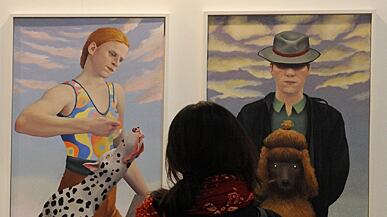Jishnue Dasgupta and Adish Patni slowly navigate through a maze of paintings, sculptures, flashing video installations, and photographs. They step in front of an enormous oil painting depicting a half-eaten bowl of rice. It’s one of several new paintings by Subodh Gupta, one of India’s foremost contemporary artists. Patni takes notes, while Dasgupta quietly comments on the work. Both are students in their early 20s, and both have traveled outside India to visit some of the world’s foremost art museums and galleries. They are part of the new India, where the booming economy is fueling an increase of knowledge and demand for luxuries like art.
Gallery: India Art Summit

At the third edition of the India Art Summit in New Delhi last weekend, collectors and a growing number of new buyers, who can now afford such purchases, snapped up works by F.N. Souza, S.H. Raza, M.F. Husain, Anish Kapoor, Pablo Picasso, and a host of emerging contemporary artists. Neha Kirpal, the director of the India Art Summit, believes events like this may be the tipping point for India’s budding art market.
“One of the prime reasons we did this art fair was because in India, the key problem is access,” says Kirpal, a vivacious young Indian entrepreneur, who started the summit in 2008. “We are a country that is so rich in art and culture but people don’t get to see it because we don’t have many museums and galleries.” More than 128,000 people attended the summit this year, quite the jump from 40,000 last year. “Most of the galleries did really well, some of them sold out twice over,” said Kirpal. She said the total sales for the summit have not been confirmed, but are believed to be well over $8 million.
While Dasgupta and Patni are just beginning to feel out artistic ventures, seasoned collectors like Gigi Mahoney used the summit to expand their collections. He bought six paintings from artists including Nilofer Suleman, Ketna Patel, and The Singh Twins with prices ranging from $150,000 to $900,000.
“I was looking for Indian artists that I have not heard of before, whose work is colorful and different, but makes sense, whether it is an installation or a painting,” said Mahoney. “A lot of the painters I buy from are people in their 20s who might have been born here and then lived abroad for several years but still kept this kind of Indian identity in their work.” A wealthy Indian in his mid-40s, Mahoney is immaculately dressed with a scarf and vintage spectacles. He carries the air of someone who feels comfortable in the art world. While most of the collectors present were of Indian origin, international interest in the summit is increasing every year.
“The art summit provides a gateway,” said Kirpal. “It gives the rest of the world access to a really large country geographically—as small a market as it may be today—and introduces the potential of the market.” She said the international art galleries have doubled here since last year because they see the future potential buying power of the market.
According to Willem Baars, who traveled from the Netherlands to show his collection of work by Pablo Picasso, the painter was popular with Indian collectors. He sold four of the six Picassos he brought. “Most of the people I sold to were lovely couples who were well-educated about the pieces they were buying,” said Baars. “They wanted the paintings for their home and were not interested in wheeling and dealing.” He said the paintings ranged from $12,000 up to $32,000. “Collectors in India know about Picasso but they are not used to seeing these paintings here. I think that is one of the reasons they are such a hot buy.”
Minal Vazirani, the president and co-founder of Saffronart, one of the world’s largest online fine art auction houses, came to the summit to see new trends. “I think there is a much stronger inclination than there ever was before to buy sculptures, to buy installations,” she said. A relatively new phenomenon in India, visitors were particularly intrigued by video installations, where images seemed to dance across the wall in 3-D. According to Kirpal, the total sale of these visual pieces was between $700,000 and $800,000.
Thirsty for art, new collectors are playing an increasingly important role in the market. Over half of the work sold at the summit was purchased by first-time buyers. Galleries and artists notice this is a trend that’s happening across India. Raghava KK, a youthful contemporary artist, said his clientele continues to get younger with his most frequent collector being a 30-year-old businessman in Mumbai.
• India’s Online Auction HouseAs Vazirani notes, the global recession busted the high-price ceiling of Indian art and made it possible for a much wider group of people to purchase high-end works.
Though they may not possess much purchasing power yet, it’s young art enthusiasts like Dasgupta and Patni who could be the next big collectors. They are gravitating away from more established contemporary painters like Subodh Gupta. He made his name nearly a decade ago with oil paintings that depicted Indian cooking utensils. The boys are looking toward the next generation of young artists, such as Raghava. An inventive 31 year old, Raghava says he often uses computer viruses as inspiration to create the movement in his work.
While Vazirani says the Indian market still has a long way to go, the future looks promising. A growing number of her top collectors are institutionalizing their work, which will increase the value of Indian art and generate awareness as more galleries and museums open across the country. In the meantime, she’ll start planning the summit’s return next year.
Plus: Check out Art Beast, for galleries, interviews with artists, and photos from the hottest parties.
Rebecca Byerly is a multi-media international journalist who frequently reports for TIME, National Geographic, CNN, Wall Street Journal, and other major media organizations. She has reported extensively from Asia and was the only international correspondent based in Kashmir from 2009-2010. A graduate of American University, in Washington D.C., Rebecca's educational background is in Peace and Conflict Resolution. She is a Boren National Security Scholar, Rotary Ambassadorial Scholar, and Pulitzer Center on Crisis Reporting fellowship recipient.






